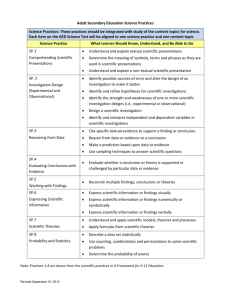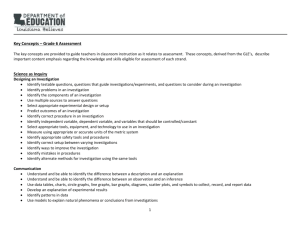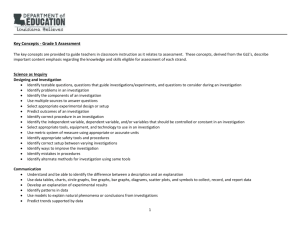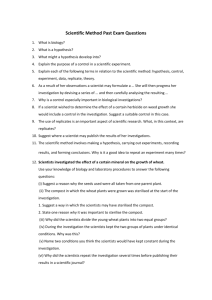Adding Depth and Complexity to Your Lessons Grade Level(s): 1
advertisement
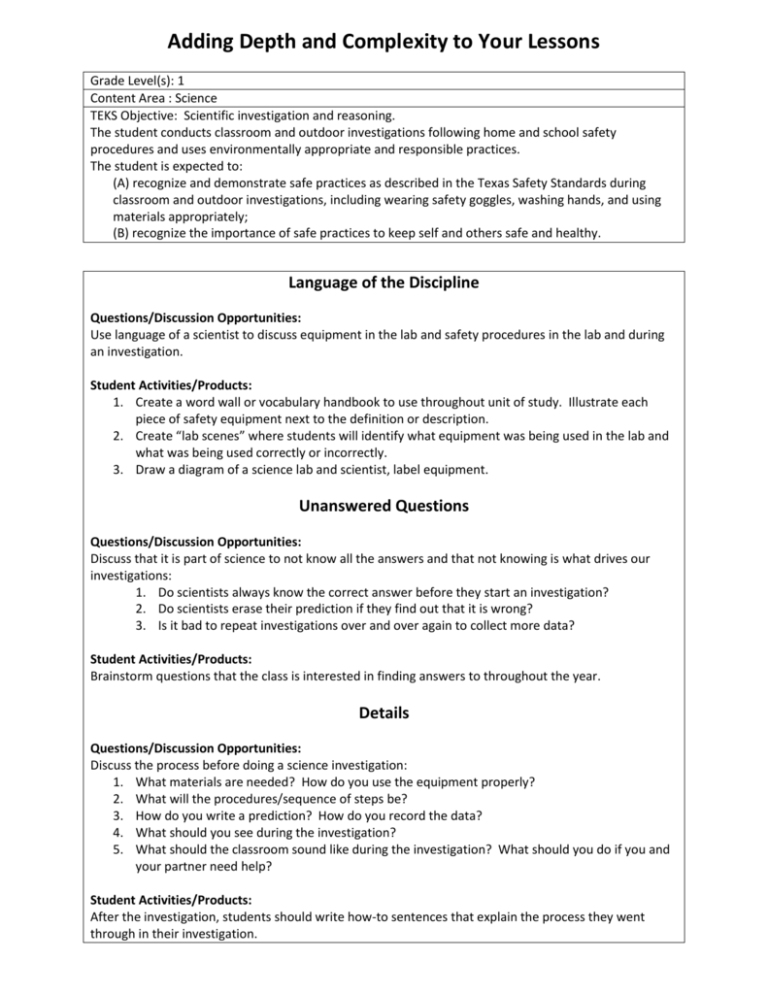
Adding Depth and Complexity to Your Lessons Grade Level(s): 1 Content Area : Science TEKS Objective: Scientific investigation and reasoning. The student conducts classroom and outdoor investigations following home and school safety procedures and uses environmentally appropriate and responsible practices. The student is expected to: (A) recognize and demonstrate safe practices as described in the Texas Safety Standards during classroom and outdoor investigations, including wearing safety goggles, washing hands, and using materials appropriately; (B) recognize the importance of safe practices to keep self and others safe and healthy. Language of the Discipline Questions/Discussion Opportunities: Use language of a scientist to discuss equipment in the lab and safety procedures in the lab and during an investigation. Student Activities/Products: 1. Create a word wall or vocabulary handbook to use throughout unit of study. Illustrate each piece of safety equipment next to the definition or description. 2. Create “lab scenes” where students will identify what equipment was being used in the lab and what was being used correctly or incorrectly. 3. Draw a diagram of a science lab and scientist, label equipment. Unanswered Questions Questions/Discussion Opportunities: Discuss that it is part of science to not know all the answers and that not knowing is what drives our investigations: 1. Do scientists always know the correct answer before they start an investigation? 2. Do scientists erase their prediction if they find out that it is wrong? 3. Is it bad to repeat investigations over and over again to collect more data? Student Activities/Products: Brainstorm questions that the class is interested in finding answers to throughout the year. Details Questions/Discussion Opportunities: Discuss the process before doing a science investigation: 1. What materials are needed? How do you use the equipment properly? 2. What will the procedures/sequence of steps be? 3. How do you write a prediction? How do you record the data? 4. What should you see during the investigation? 5. What should the classroom sound like during the investigation? What should you do if you and your partner need help? Student Activities/Products: After the investigation, students should write how-to sentences that explain the process they went through in their investigation. Adding Depth and Complexity to Your Lessons Grade Level(s): 1 Content Area : Science TEKS Objective: Scientific investigation and reasoning. The student conducts classroom and outdoor investigations following home and school safety procedures and uses environmentally appropriate and responsible practices. The student is expected to: (A) recognize and demonstrate safe practices as described in the Texas Safety Standards during classroom and outdoor investigations, including wearing safety goggles, washing hands, and using materials appropriately; (B) recognize the importance of safe practices to keep self and others safe and healthy. Patterns Questions/Discussion Opportunities: 1. What reoccurring events can be expected in science? 2. What similarities will there be in the process of every investigation we complete? (review expectations, set learning goal, make prediction for investigation, record data, review learning) 3. How can we make connections and see patterns across our studies of Physical Science, Earth and Space Science, and Life Science? Student Activities/Products: Create an ongoing concept map that organizes information learned in each unit and connects to previous and future learning. Rules Questions/Discussion Opportunities: What rules must we follow while we are using science equipment? What rules must we follow when we are involved in an investigation? Student Activities/Products: Determine science rules and procedures. Have students illustrate each rule on a poster with examples and non-examples. Multiple Perspectives Questions/Discussion Opportunities: Why is it important to consider all students’ opinions? Why is it important to be a good listener during science activities? Big Ideas Questions/Discussion Opportunities: What is the relationship between change and science safe practices? Discuss how choices can impact yourself, your lab partner, the equipment, and your classroom. Student Activities/Products: Act out several scenarios, e.g., students following lab rules, students breaking a lab rule, students misusing equipment etc. Students watching the skit should identify what the students in the scene are Adding Depth and Complexity to Your Lessons Grade Level(s): 1 Content Area : Science TEKS Objective: Scientific investigation and reasoning. The student conducts classroom and outdoor investigations following home and school safety procedures and uses environmentally appropriate and responsible practices. The student is expected to: (A) recognize and demonstrate safe practices as described in the Texas Safety Standards during classroom and outdoor investigations, including wearing safety goggles, washing hands, and using materials appropriately; (B) recognize the importance of safe practices to keep self and others safe and healthy. doing right and what the students are doing wrong. Students can discuss how lab results can change if you modify one of the variables. Relate over Time Questions/Discussion Opportunities: 1. How has lab equipment changed over time? 2. How can looking at the past help us make safe choices in science? 3. What can we learn from last week’s investigation that will improve our next investigation? 4. How do our choices in how we use science equipment affect future students at our school? Student Activities/Products: Write a reflection or illustrate what I can do differently in the next lab. Parallel Questions/Discussion Opportunities: What similarities are there to our classroom science rules and NASA science rules? How is our scientific process similar to scientists working in various industries? Student Activities/Products: 1. Write a letter to a scientist asking about their equipment and lab rules. 2. Use a Venn diagram to explain similarities and differences between our classroom lab and a professional lab. Convergence Questions/Discussion Opportunities: What is each student’s role in an investigation to ensure that everyone is safe and the investigation is complete? Student Activities/Products: Define science job cards and each job’s responsibilities. Discuss how each member of the team must work together because each job is important. Contribution Questions/Discussion Opportunities: 1. Why is safety important? 2. What contribution does each student make in an investigation? 3. What contributions do scientists make for our community? Adding Depth and Complexity to Your Lessons Grade Level(s): 1 Content Area : Science TEKS Objective: Scientific investigation and reasoning. The student conducts classroom and outdoor investigations following home and school safety procedures and uses environmentally appropriate and responsible practices. The student is expected to: (A) recognize and demonstrate safe practices as described in the Texas Safety Standards during classroom and outdoor investigations, including wearing safety goggles, washing hands, and using materials appropriately; (B) recognize the importance of safe practices to keep self and others safe and healthy. Student Activities/Products: Make an “Important book” about science, scientists, and safety. Origin Questions/Discussion Opportunities: Why is science taught in school? Why is it important to learn about Physical Science, Earth and Space Science, and/or Life Science? Paradox Questions/Discussion Opportunities: What if you get contradictory results in an investigation? Discuss how scientists revise their plan and complete more tests to gather more data. Student Activities/Products: Compare results in an investigation. Chart data. If discrepancies arise, repeat investigation and discuss why the data looks different among the groups.

